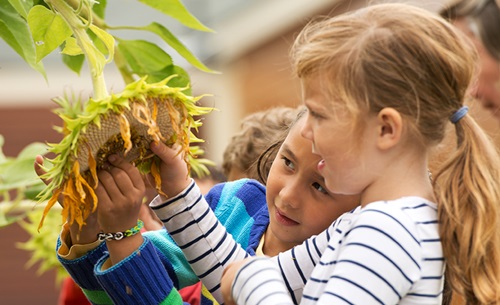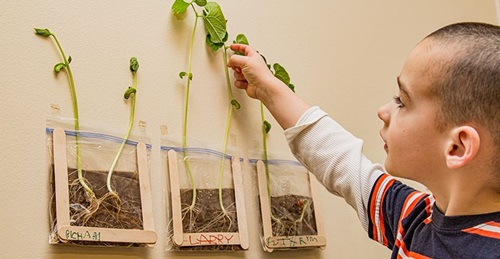Wonder: A Many Splendored Thing
| August 2018What is wonder?
We feel wonder in our hearts, play with wonder in our minds, and know wonder’s ability to uplift our spirits. Yet, defining wonder and understanding what it really means can be elusive. Deb Schein (2018) defines wonder as “feelings of surprise mingled with respect or admiration stimulated by beauty, the unexpected, or the unfamiliar” (p. 79). Wonder is an emotion. But as Schein says, wonder also implies curiosity, a desire to know something. Wonder is cognitive. What we wonder about, however, often relates to the “big questions” of life—questions about purpose, identity, and connections. Wonder has spiritual aspects (Wilson, 2018). Wonder is multi-faceted and important to our lives. Encompassing emotional, cognitive, and spiritual aspects—wonder is, in fact, a many splendored thing.
As an educator, teacher educator, and author, I’ve thought a great deal about the meaning and role of wonder in the lives of young children. One of my first books, Fostering a Sense of Wonder During the Early Childhood Years, focused on the importance of wonder in fostering holistic development. Wonder is referred to in almost every book or article I’ve written in the 25 years since then. I’m not alone in my fascination with wonder and the role it plays in our lives, especially the lives of children. From Rachel Carson’s book—The Sense of Wonder (first published in 1956)—to the many books on the market today for early childhood educators, wonder is an important theme. Some books focus on the educational value of wonder—the way wonder drives curiosity, exploration, and learning. Other books focus on the more spiritual aspects of wonder and discuss ways in which wonder relates to awe, empathy, and the experience of the sublime. Some books focus on the emotional and aesthetic aspects of wonder, reminding us that life without wonder is greatly diminished. Some books refer to wonder as a “survival skill” and suggest that wonder can serve as an antidote to an overly busy and distracted life (Blake, 2012). Wonder can also be an antidote to our estrangement from the world of nature and its inherent beauty.
Many educators recognize wonder as a powerful motivator for learning. We’re supported in this understanding by some famous thinkers. According to Plato, “Wonder is the source of knowledge”; and in the words of Socrates, “Wonder is the beginning of wisdom.” Edith Cobb, a more contemporary thought-leader, suggests that wonder helps us to know the world. Wonder, she says, is the wellspring of knowledge, the basis of creativity and imagination (Cobb, 1998). So, with all this being said about wonder, why do I still spend so much time and energy thinking about wonder in the lives of young children? Maybe because there’s still something missing, or perhaps left unsaid, about the role of wonder in our lives, especially wonder as it relates to our relationship with nature.
We know that engagement with nature fosters a sense of wonder. The experience of wonder while engaged with nature is often inspired by the beauty or immensity of nature. At times, it can be inspired by what’s mysterious about nature. Albert Einstein must have experienced this aspect of wonder when he said, “The most beautiful thing we can experience is the mysterious.” According to the biophilia hypothesis, humans have an innate affinity for nature (Wilson, 1984). Biophilia, like wonder, has cognitive, emotional, and spiritual aspects. It has obvious ecological dimensions as well. I believe the same applies to wonder. By this, I mean the origins of wonder are firmly fixed in our connections with the natural world. Perhaps the culmination of wonder resides there, too.
I recently searched in the Children & Nature Network Research Library to see what the academic literature has to say about wonder in the lives of young children. One study (Schein, 2014) was designed specifically to develop a theory of spiritual development for young children. After conducting in-depth interviews with twelve early childhood education specialists and reviewing journal notes taken by three of the participants, the researcher concluded that spirituality includes a sense of wonder and awe, and that nature is a conduit for developing these dynamic attributes.
Other studies have examined children’s own perceptions about and responses to nature. In one such study focusing on children’s experiences during nature play, six- and seven-year-old students highlighted their emotional reactions to feeling close to nature. They described “feelings of calm and peacefulness, feelings of freedom, or wonder, joy and excitement about the spaciousness and beauty they experienced, and their happiness from being in nature” (Francis et al., 2013, p. 26). In another study, five- to ten-year-old children shared their ideas and feelings about nature through focus group discussions and drawings (Rios & Menezes, 2017). Their responses reflected a deep emotional connection with nature along with a strongly protective disposition towards nature, evident in such statements as “I saw a magical garden with flowers that people could not damage!” (p. 2). This child’s statement suggests that emotional connections with nature are linked to caring for the environment. We find discussions about the association between love of nature and care for nature frequently in the literature. Selby says that nurturing a sense of wonder, joy, and belonging in children as they experience nature is vital to developing an ethic of care for the planet (2017).
Wonder is more than a frill in the lives of young children. Wonder fosters learning, imagination, spiritual development, emotional health, and care for the planet. Teachers and other adults working with young children can foster wonder in a number of ways, but perhaps the most effective way is to encourage deep engagement with nature. Deep engagement involves more than just being in nature. It involves “attunement” (Cornell, 2017) and awakens a sense of wonder rooted in the realization that nature and self are one.
References
Blake, H.E. 2012. Wonder and Other Survival Skills. Great Barrington, MA: Orion Society
Carson, R. 1956. The Sense of Wonder, New York: Harper & Row
Cobb, E. 1998. The Ecology of Imagination in Childhood. Putnam, Connecticut: Spring Publication
Cornell, J.B. 2017. Deep Nature Play. Nevada City, CA: Chrystal Clarity Publishers
Francis, M., K. Paige & D. Lloyd. 2013. Middle years students' experiences in nature: A case study on nature-play. Teaching Science, 59(2), 20-30.
Rios, C. & I. Menezes. 2017. 'I saw a magical garden with flowers that people could not damage!': Children's visions of nature and of learning about nature in and out of school. Environmental Education Research, 23(10), 1402-1413.
Schein, D. 2018. Inspiring Wonder, Awe, and Empathy. St. Paul, MN: Redleaf Press
Schein, D. 2014. Nature’s role in children’s spiritual development. Children, Youth and Environments, 24(2), 78-101
Selby, D. 2017. Education for sustainable development, nature, and vernacular learning. CEPS Journal, 7(1), 9-27.
Wilson, E.O. 1984. Biophilia, Cambridge, MA: Harvard University Press
Wilson, R. 2018. Nature and Young Children, 3rd edition, New York: Routledge










